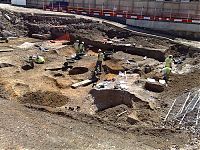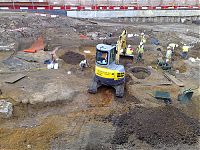Remembering the dead
- By: Ashley Pooley |
- Aug 19, 2008
- Share
- del.icio.us

We finished an area of the site on Friday, which involved removing by machine dumps resulting from the backfilling of quarries. This forms the earliest activity on site encountered thus far and it’s (mildly) interesting to speculate exactly what’s going on here. Is it a case simply of the quarries being used to dump the Roman equivalent of landfill in which case why (compared, for instance, with the material encountered in relict channel fills in the Southwark area) is there relatively little artefactual inclusions within these dumps? Or is there a phase here of deliberate “reinstatement” (as we’d say in the building trade) of this quarried area preparatory for its use as a cemetery (which begs the further question of whether this shows some form of institutional planning and work in this area by the Romano-British urban authorities?)
It’s also become apparent that Roman dumped deposits overlie and separate stratigraphically many of the (often shallow) grave cuts that we’re encountering at the moment. This suggests that the cemetery was much less static in its development than we might assume from our impressions of tidy municipal cemeteries today. Put simply, this means that spoil was being dumped over graves and the ground level being raised at least periodically which has implications for how these people were remembered and commemorated over any appreciable length of time. Add to that the problems attendant on accurately marking graves in a period when most of the population was illiterate, and we can begin to appreciate that remembering the dead and envisioning them (and particularly their remains) in a place within a “living present” was a lot more complicated than we might imagine. But then we’re also frequently a lot more complicated and strange that we like to let on to ourselves. Particularly when it comes to the dying of the light.
- (0)

